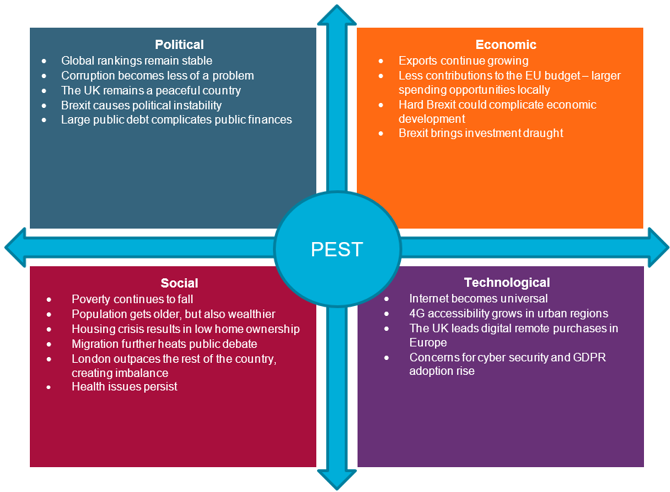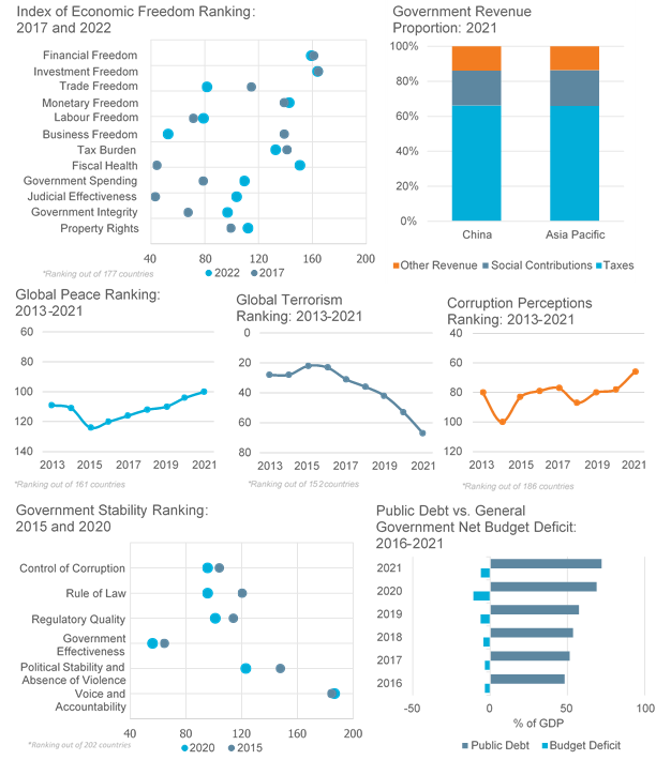Let’s say you have a brilliant idea to develop a new product or expand your geographic presence. You’ve identified your USPs, target audience, pricing strategy, among others. But to be successful, you need to understand and adapt to what’s around you. A lot of these external factors are things you can’t control.
Sounds hard, right? Well, it doesn’t have to be.
Conducting a PEST analysis can help executives control the uncontrollable and proactively make the right business decisions. This article breaks down how this research tool can help prevent risk and spot areas for growth.
What is a PEST analysis?
It’s a strategic framework used to evaluate external opportunities and threats for a business, looking at Political, Economic, Social and Technological factors.
Political
Political factors revolve around how government policy and actions affect the economy of a country and industries. Here, political stability, ease of doing business as well as relevant laws and regulations are key focus areas for businesses.
Economic
This factor describes the conditions and performance of an economy, reflected in key economic indicators such as growth, unemployment, inflation rate and interest rate. Economic circumstances significantly impact business operations due to their influence on consumer behaviour.
Social
Social factors focus on demographic and cultural trends of a country and their impact on the business environment. Population growth, age distribution and degree of urbanisation may vary significantly between countries, just like consumer habits and values that influence their expectations.
Technological
This looks at the pace of tech advancement and change in an economy. It’s linked to the level of innovation in various industries, the digital landscape and the penetration rate of advanced technologies among consumers.
Why should you use a PEST analysis to guide business decisions?
Because you’ll know the big-picture-forces and direction of change that could impact the profitability of your company.
Tip: Use it in conjunction with other forms of strategic business analysis like the SWOT (strengths, weaknesses, opportunities, threats) analysis. The PEST analysis will identify the external factors, whereas the SWOT analysis explores the competitive placement of a company within a market.
Then, you’ll want to develop a detailed evaluation of your existing strategy and align these new insights with your next business move.
This part is critical. You’ll most likely have to make some big strategy adjustments. And that’s ok. Here’s why. In the long-run, this will put your company one-step ahead of competition because you looked at the big picture and uncovered where you need to focus your efforts. Others will be trying to catch up with the current environment.
Now, it’s time to put this into action.
Tool into practice
China serves as a prime example of where a PEST analysis can play a difference in your strategic planning. Let’s dig into why.
The country’s rapid economic growth fuelled development in every aspect of society, making China highly attractive for investment. However, its economic dynamism also sparked hasty changes in other fields. And if companies aren’t aware of this, it could threaten their success.
Let’s start by breaking down each factor.
PEST Analysis for China

Say you’re a retailer looking to enter China with onsite logistics. If you’re just looking at China’s basic economic data, you’d see there is high growth potential due to a rise in projected growth and its large middle class.
But since you did a thorough PEST analysis, you found several threats that could impact success.
First, you spot issues with tech. As a largely store-based player, the retailer faces massive online competition. E-commerce is huge in China. These digital-first consumers want to shop online. And you’ll be losing sales if your business doesn’t match up. A stark contrast compared to your home market.
Second, political factors point toward an adverse business environment for foreign companies. You quickly realize it’s an uneven playing field and there will be property rights issues. Plus, consumers prefer to buy products from domestic companies.
If you just looked at China’s projected economic growth, you would have missed out on big threats. But instead, the PEST analysis revealed all the potential risks of entering a new market. Now, you’re ready to act on your findings with a complete understanding of the best approach forward.
Where to find information for your PEST Analysis
Each section—political, environmental, social and technological—requires different information. This can be super time consuming. And it’s hard to know which data you can trust.
To make it easier, Euromonitor provides PEST reports for 210 countries. These reports leverage a comprehensive set of relevant socio-economic data points, providing a visual overview of past and future trends and developments.
You’ll easily be able to see how each country ranks, the risks, the stability of the economy, what are the best sectors for investment and where you should focus your expansion strategy.

Example: Economic Environment Dynamics in China
Source: Euromonitor International
Key Takeaways
- Use a PEST analysis to identify the external factors that could impact your company’s success.
- Don’t do a PEST analysis in isolation. Executives should conduct a SWOT analysis as well to evaluate the pros and cons of major decisions.
- You need reliable and relevant data to make the right decisions. Find a market research tool that you trust like Passport data and use that with our PEST reports to get a full picture view of any country or industry.
- Gaining a clear perspective on your growth opportunities and risks will help you succeed in the long term.
